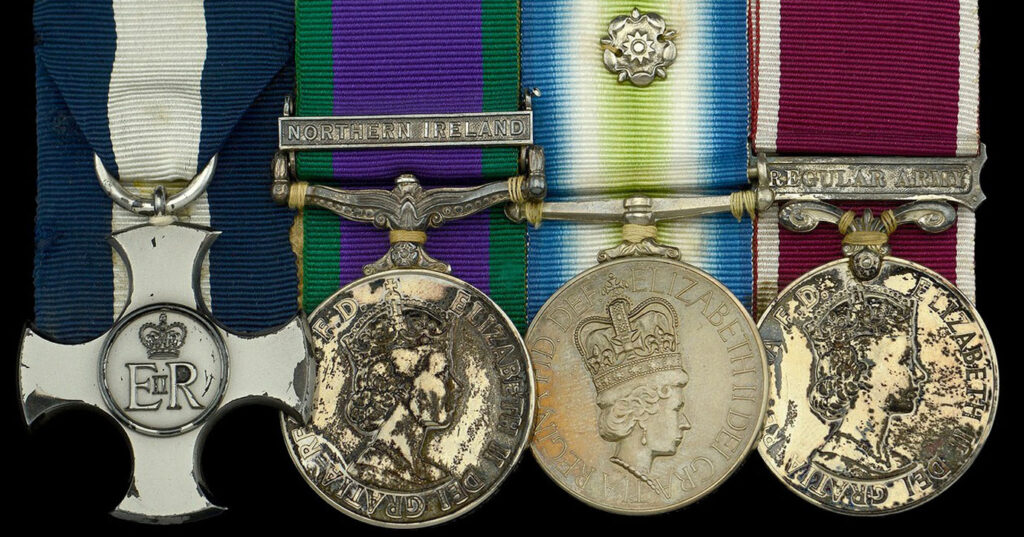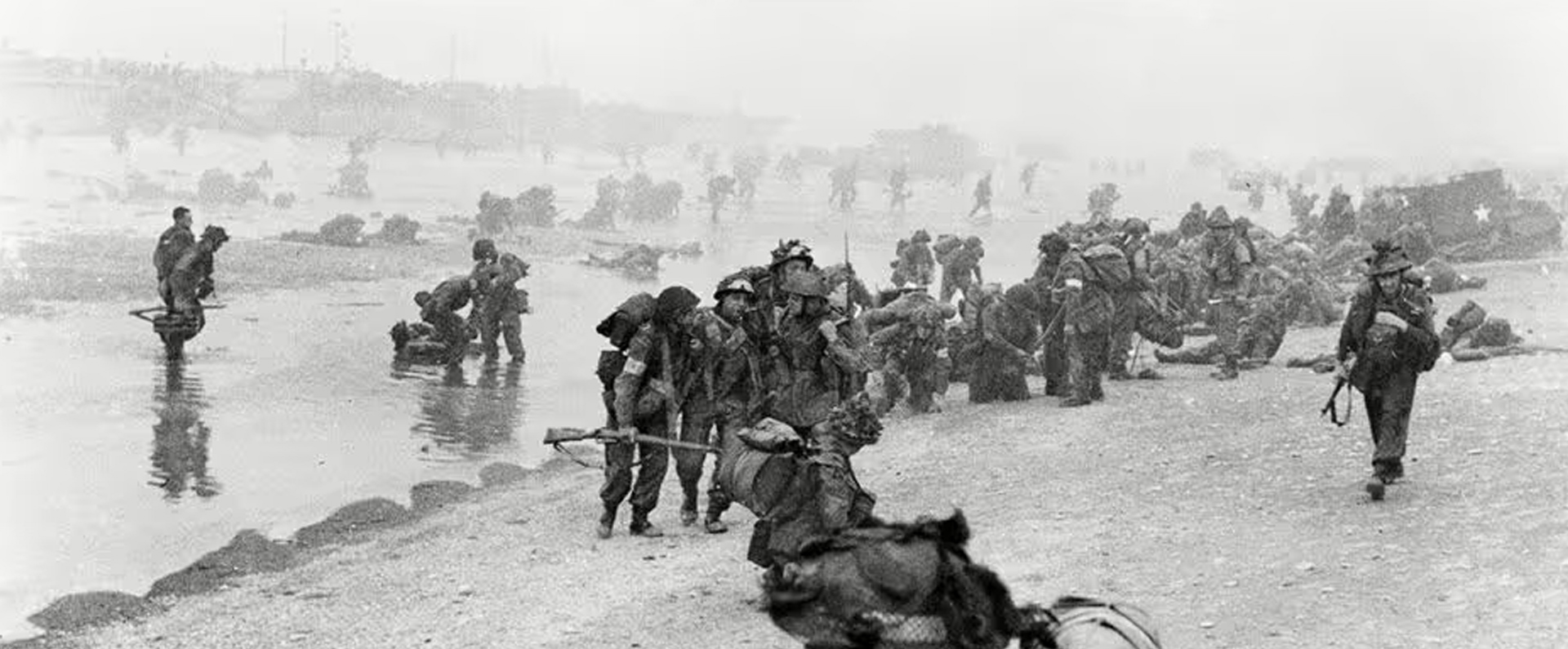
First published in The Mail on Sunday on 13 March 2022.
Military historian Lord Ashcroft has followed up his latest book about bravery, Falklands War Heroes, by writing about those whose valour has largely gone unsung.
In yesterday’s Daily Mail, he saluted the remarkable efforts of the Falklanders themselves to repel the Argentinians. Here, he tells of the courage of key British servicemen.
Every time John Phillips looks in the mirror he is reminded of the Falklands War 40 years ago. That’s because the left sleeves of his shirt and jumper are always neatly tucked away out of sight.
As his left arm was ripped off at the shoulder while undertaking dangerous bomb disposal work, the sleeves are surplus to requirements.
For a time, he sported one of the three prosthetic arms provided for him by the Army but then he discarded them all.
‘At one point, I had an arm for everything! But then I stopped using them all and I thought, ‘Take me as I am,’ ‘ Phillips said.
Of the two bomb disposal men tackling an exploded Argentine bomb on the frigate HMS Antelope, Phillips was the luckier one. His comrade, Staff Sergeant Jim Prescott, standing next to him, was killed when a 1,000 lb bomb they were trying to defuse detonated just 30ft from the men.
Today, Phillips, who is a few months shy of his 80th birthday, has no feelings of resentment about the war that changed his life.
After Argentina invaded the remote South Atlantic islands on April 2, 1982, he volunteered to travel 8,000 miles from Britain for a potentially deadly assignment.
In an exclusive interview at his home in Woking, Surrey, Phillips, greying, bespectacled and dressed in a salmon-coloured jumper and pink check shirt, took pride in the fact he played his part in winning back the freedom of 1,820 islanders and that, quite remarkably, he returned to his job as a bomb disposal expert just over three months after losing his arm.
I came across a second-hand account of Phillips’s gallantry, for which he was awarded the Distinguished Service Cross (DSC), when I was researching my book Falklands War Heroes, published last November.
However, immediately before the 40th anniversary of the war, I wanted to learn from the man himself just what had happened and he was only too willing to recall the tragic events of May 23, 1982.
Understandably though, his voice broke and he shed a tear when he recalled the terrifying moment his fellow bomb disposal expert lost his life and he himself was badly injured.
John Phillips was born during the Second World War in Warwick in December 1942. The son of a long-distance lorry driver and the eldest of three children, he moved to Coventry with his family when he was just over a year old.
Phillips left school at 15 without qualifications before being accepted into the Army in 1958. He then did a three-year apprenticeship as a fitter.
In 1961, he enrolled in the Royal Engineers as a sapper and was given the opportunity to train as a bomb disposal officer in 1965. As he was promoted, he developed his skills and undertook foreign tours.
He was 39 years old and serving in the rank of sergeant major with 33 Engineer Regiment EOD (Explosive Ordnance Disposal) when Argentina invaded the Falklands.
‘At the time, I was on Easter leave. I was in my garden laying flagstones when I received a call from my Officer Commanding, Major Guy Lucas, who told me he had two members of the regiment on the Task Force and who should go. My immediate reaction was, ‘I am one of them, who is the other?’ I had waited 20 years for this moment.’
After a week’s preparation, Phillips and his comrade, Jim Prescott, sailed to the Falklands on board HMS Canberra, the cruise ship requisitioned to transport military personnel and equipment to the Falklands as part of the British Task Force. When they reached Ascension Island, they were transferred to RFA Sir Lancelot, a landing ship.
Initially, it seemed diplomacy might avert war, but once, in early May, the Argentine light cruiser General Belgrano and the British destroyer HMS Sheffield were hit by their respective enemy with many lives lost, all-out war seemed inevitable.
‘After these events, we thought ‘this is for real’ and the atmosphere on board changed,’ said Phillips.
Sir Lancelot arrived in San Carlos Bay, East Falkland, on a sunny spring day: May 21. The two bomb disposal men initially helped unload equipment and were tasked the next day to tackle two unexploded bombs that had hit the frigate HMS Argonaut, killing two crewmen.
‘There was one bomb in the boiler room and one in the forward magazine. The boiler room bomb had damaged a lot of equipment. They were British-made 1,000 lb bombs which we had the equipment to deal with.’
The next day, however, they had a second, more serious incident to attend to after HMS Antelope, a Type 21 frigate, was attacked by four Skyhawk jets. Once again, they had to deal with two unexploded 1,000 lb bombs.
Phillips recalled: ‘The crew took us to where the unexploded bombs were: one was in the forward petty officers’ mess and had come through the side of the ship at water level, killing 18-year-old steward Mark Stephens. It was just sitting there on a petty officer’s bunk, but it had done so much damage that we couldn’t reach it.
So we had a look at the second bomb, which was in the refrigeration unit further aft, and this was more accessible. Jim and I decided we would clear all the men away to the top deck. The crew had wedged the bomb to stop it rolling. It was the same type of bomb we had dealt with the day before, so we were quite confident.’
The two men tried to get the ‘pistol’ out of the ‘tail’, or back, of the bomb by attaching a ‘rocket wrench’ to it. A rocket wrench is a square metal frame with cartridge tubes and is roughly the width of a wheelbarrow wheel.
‘We retired to a relatively safe position near the control room and we fired it [the rocket wrench] electronically through cables. The theory is that there is a Catherine-wheel effect where the device spins fast to unthread the pistol, separating it from the bomb.
‘But this particular pistol had been damaged on its way into the ship, so it didn’t spin off. So I went forward and had another go attaching the rocket wrench to the pistol and then retired. After firing the rocket wrench again and waiting, I went forward again but the same thing – it had spun off without taking the pistol out.
‘So I had a third attempt tightening the rocket wrench as tight as I dared on to the pistol. Again I retired back about 30ft, or two bulkheads, and fired again. Same thing – so I went forward yet again and then retired once more.
‘On the fourth attempt to render safe the bomb, there was an almighty explosion. There was a big vibration: Jim and I looked each other in the eyes and I thought, ‘Sh*t!’ The next thing I knew, I was flying through the air and I didn’t know where Jim was.
‘I hit the bulkhead with my backside and I could see my left arm was injured because it was floating around. Then I hit the deck. It took me a while to come to my senses and I started looking for Jim but I couldn’t find him.’
Understandably, Phillips’s voice broke as he carried on: ‘Then a crewman came down and his words, which I will never forget, were, ‘Don’t mind him, he’s dead. Follow me.’
So I put my right hand on his shoulder and followed him to the escape hatch on to the flight deck. I was then treated by the ship’s doctor.
They gave me my morphine, which we carried around our neck, as a jab in my thigh. Then they put an ‘M’ on my forehead [to indicate he had received morphine].
‘Antelope was ablaze, so we abandoned ship on to a landing craft that would take me to Ajax Bay hospital. By now, I was lying on a stretcher watching the ship burning, thinking, ‘We had better get out of here soon because there is going to be another explosion.’
‘Then, when we were halfway to Ajax Bay, there was that explosion – the one that produced the famous photograph of the silhouette of the ship exploding in the night. I was about a quarter of a mile from the ship at the time but all the crew had managed to escape.’
At Ajax Bay, Phillips was treated by Surgeon Captain Rick Jolly, whom he had met on Canberra during the journey down to the Falklands. ‘My arm had been severed – it was floppy, disconnected and had only stayed with me because it was inside my pullover. When I came around after the initial operation, the surgeon said to me, ‘We have had to take your arm off.’ And I just nodded to him to indicate that I understood. I can remember it as if it was yesterday. I was just grateful to be alive.’
Phillips was treated for two days before being moved again. He said: ‘On Tuesday, May 25, I was flown to the hospital ship SS Uganda. The next day, Ajax Bay was bombed and nine men were killed.’
Over the next few weeks, Phillips underwent several operations while being treated on Uganda. Next, he was transferred to the hospital ship HMS Hydra and taken to the Uruguayan capital Montevideo, from where he was flown home to RAF Wroughton, Wiltshire.
There, he was met by his wife Christine and his commanding officer, Major Lucas, who took him in his staff car to Woolwich Hospital in South-East London for further treatment.
Phillips eventually learnt that the explosion had ripped off two bulkhead doors and one had hit himself and Jim Prescott, killing his comrade outright. He reasoned that the bomb had detonated because of the initial damage and the attempts he had made to defuse it over a period of about two hours.
Phillips said: ‘I initially thought my military career was over, especially when my replacement in the regiment came to see me in Woolwich Hospital. That gave me the incentive to get myself fit.’
Phillips discharged himself from hospital knowing that his wife, a registered nurse, could change his dressings and care for him at home. ‘I was worried I’d lose my job so I got myself relatively fit and went back to work after the August Bank holiday. I was sidelined for a while because they kept my replacement in situ. But soon I returned to my old job. I started behind a desk but I then put myself on the duties list as a BDO [bomb disposal officer], and I got called to deal with a mine on the South Coast.
‘I wanted to show I was still the John Phillips I was before. But eventually I realised I wasn’t really up to doing the work I had done. The rest of the team were helping me out.’
It was several weeks after Phillips returned to work that he learned he had been awarded the DSC. Jim Prescott, too, was shortlisted for the Victoria Cross (VC) but received a posthumous Conspicuous Gallantry Medal (CGM). Phillips was invested by the Queen at Buckingham Palace.
‘I called her ‘sir’, because I was so nervous – because everyone I had spoken to previously had been ‘sir’. She must have thought I was a right plonker. But she asked me how I was and whether I was back on duty.’
Phillips says he took Premature Voluntary Release – in the rank of captain in 1989 because he was dissatisfied with his military role, which had included working as a bomb disposal instructor. Next, he worked for the security services, specialising in explosive and bomb disposal, until fully retiring on his 58th birthday.
Today, Phillips is married and has three children, six grandchildren and five great-grandchildren. His son, Neil, also served in the Royal Engineers as a bomb disposal officer, enjoying a 24-year military career, during which he was wounded by shrapnel when an improvised explosive device exploded during a tour of Afghanistan. He retired in the rank of staff sergeant.
Phillips told me he still suffers ‘phantom pain’ – a pain that feels as if it’s coming from a body part that’s no longer there – and takes painkillers when this condition is at its worst.
‘They say ‘phantom pain’ is in the mind. But I can assure you it’s not. It really exists,’ Phillips said.
He does not suffer post-traumatic stress disorder or nightmares, but he constantly recalls the blast in his mind.
‘I was conscious all the time – which was probably a saving grace,’ he added.
He first went back to the Falklands with his wife for the tenth anniversary of the war and has returned five times since. He will visit again in November for Remembrance Sunday during the 40th anniversary of the war and, given his age, expects this to be his last trip to the islands.
Forty years on, how does he feel about the war and his role in it?
Without taking a breath, John Phillips replied: ‘Margaret Thatcher was absolutely right to retake the Falklands. It was her moment in history and she seized it.’
His voice broke again with emotion as he spoke of his own contribution. ‘I’m extremely proud that I played my part. What the lads achieved with limited preparation was extraordinary.
It’s always on my mind – when I look in the mirror, I am reminded of the Falklands every time – but I wouldn’t have wanted things any other way.’
Read this article on MailOnline.com
For more information, visit:
LordAshcroftOnBravery.com


